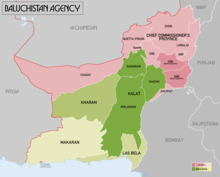This is an old revision of this page, as edited by Sir Calculus (talk | contribs) at 07:48, 15 October 2024 (Restored revision 1246024285 by Sutyarashi (talk): Rv disruption). The present address (URL) is a permanent link to this revision, which may differ significantly from the current revision.
Revision as of 07:48, 15 October 2024 by Sir Calculus (talk | contribs) (Restored revision 1246024285 by Sutyarashi (talk): Rv disruption)(diff) ← Previous revision | Latest revision (diff) | Newer revision → (diff)Brahuistan, also known as Brahvistan (Template:Lang-brh; lit. 'Land of the Brahuis') is a region in Balochistan in what are now Pakistan and Afghanistan primarily inhabited by the Brahuis, an ethnic group which natively speaks the Brahui language. In the twenty-first century, Brahui nationalism has been developed around the idea of a separate Brahuistan, consisting of Kalat in Pakistan and Registan in Afghanistan.
In the Brahui poetry and literature, Brahuistan was one of the names with which the Brahuis used to call their homeland, the others being Kalat and Mash (mountain). Historically Brahuis were pastoralists primarily confined to the Kalat region; in the 17th century various Brahui tribes were unified by the Brahui Ahmedzai dynasty which led to the creation of Khanate of Kalat or the "Brahui Confederacy". At its greatest extent in the 18th century, the Brahui confederacy controlled the wider Balochistan region. However, the traditional Brahui homeland or Brahuistan is a narrow corridor stretching from Nushki in the north to Khuzdar in the south, separating the Pashtun-majority regions in the northern Balochistan from the Baloch-majority Makran. During the British colonial period, several British ethnographers suggested the Kalat state to be renamed as Brahuistan, but the suggestion was ultimately not implemented due to the ongoing Great Game.

Brahuistan is further divided into two major parts, Sarawan in the north and Jhalawan in the south, inhabited by the Sarawani and Jhalawani Brahui tribes, respectively. Today most of Brahuistan, with the exception of Nushki, is part of Kalat Division. According to the 2023 Census of Pakistan, the districts of Khuzdar, Nushki, Kalat, Mastung and Surab have Brahui majority. Kalat Division, which consists of most of the former state of Kalat, is the only Brahui-majority division of Balochistan.
References
- ^ Brahui, Nazir Shakir (April 23, 2022). "The Rise Of A Brahui Consciousness". The Friday Times. Retrieved September 3, 2024.
- Minahan, James (2016). "Brahui". Encyclopedia of Stateless Nations: Ethnic and National Groups Around the World (2nd ed.). Santa Barbara, California: Greenwood. pp. 79–80. ISBN 978-979-8216-14-5.
Brahuistan occupies a semiarid region, forming the Kalat area of Balochistan, districts in eastern Sindh, and Registan, the southern districts of Kandahar and Helmand in Afghanistan.
- ^ Elfenbein, Josef (1989). "Brahui". In Yarshater, Ehsan (ed.). Encyclopædia Iranica. Vol. IV/4: Bolbol I–Brick. London and New York: Routledge & Kegan Paul. pp. 433–443. ISBN 978-0-71009-127-7.
- "Population by mother tongue, sex and rural/urban, census-2023" (PDF). Pakistan Bureau of Statistics.
Further reading
- Zeb, Rizwan (2019). Ethno-political Conflict in Pakistan: The Baloch Movement (1 ed.). New York: Routledge. doi:10.4324/9780429318139. ISBN 978-0-429-31813-9.